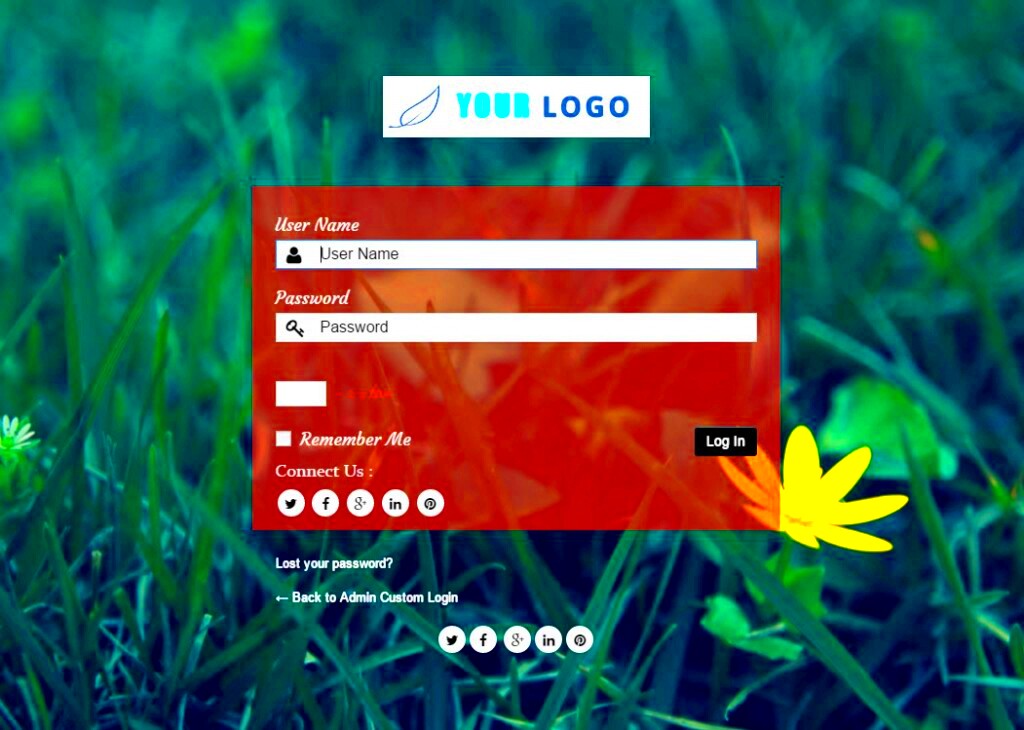When it comes to creating a unique online presence, every detail counts—even the login page! Custom login page plugins for WordPress allow you to personalize the user’s entry point into your website. These tools not only enhance the aesthetic appeal of your site but also strengthen branding and improve user experience. In this post, we’ll explore some fantastic free options that can transform your login page into a stylish gateway to your content!
Benefits of Using Custom Login Page Plugins

Now that you know what custom login page plugins are, let’s dive into why you should consider using them. Here are some notable benefits:
- Branding Opportunities: A customized login page allows you to include your logo, brand colors, and other visual elements that reflect your business, making your site instantly recognizable.
- User Experience: A well-designed login page enhances the overall user experience, making it easier and more pleasant for users to access their accounts.
- Increased Security: Many custom login page plugins come with added security features like CAPTCHA, custom login URLs, and IP address blocking, which help protect your site from unauthorized access.
- Custom Redirects: You can set up redirects post-login, guiding users to specific pages that enhance their journey without confusion.
- Flexibility and Control: With customizable options, you have the flexibility to modify the layout, fonts, and background, and you can even add custom messages or links for user convenience.
By investing in a custom login page plugin, you’re not just improving aesthetics—you’re also fostering a better relationship with your users and enhancing overall functionality!
Top Free Custom Login Page Plugins for WordPress

If you’re looking to enhance your WordPress site’s login experience, customizing your login page can do wonders! There are several free plugins available that make this process a breeze. Below are some of the top options you might want to consider:
- Custom Login Page Customizer: This user-friendly plugin allows you to tailor your login page with ease. You can change colors, backgrounds, typography, and even add your logo. The real-time customizer interface is a nice touch, making it easy to see your changes as you make them.
- Theme My Login: Not only does this plugin create a custom login page, but it also helps in creating beautiful user profiles and registration pages. You can also modify the login form’s URL, making it less predictable for some users.
- LoginPress: With an intuitive setup, LoginPress lets you design stunning login pages. You can control the login logo, background, and even add custom login messages. Plus, it comes with various pre-designed templates that can speed up the customization process.
- WPForms Lite: While primarily a form-builder plugin, WPForms Lite can be used to create a custom login form widget. It provides drag-and-drop functionalities that make form creation efficient and fun!
- Custom Login Logo: As the name suggests, this minimalistic plugin does one thing brilliantly—change the login logo on your WordPress login page. If you’re looking for a simple branding tweak, this plugin is a perfect choice.
Each of these plugins offers distinct features that cater to different needs, so explore them all to find the one that fits your site perfectly!
How to Install and Configure a Custom Login Page Plugin

Getting your custom login page up and running on your WordPress site is straightforward, even if you’re not a tech genius! Here’s a step-by-step guide on how to install and configure a custom login page plugin:
- Log into your WordPress Dashboard: Navigate to your WordPress site and sign in using your admin credentials.
- Go to Plugins: On the left sidebar, click on “Plugins” and then select “Add New.” This will take you to the plugin directory.
- Search for Your Desired Plugin: In the search bar, type the name of the custom login page plugin you’d like to install, for example, “Custom Login Page Customizer.”
- Install the Plugin: Click the “Install Now” button next to the plugin you want to use. Once it’s installed, you’ll see the option to activate the plugin.
- Activate the Plugin: Click on “Activate” to enable the plugin on your site. Once activated, you might see a new menu item on your sidebar dedicated to the plugin.
- Configure Plugin Settings: Navigate to the plugin settings by clicking on the new menu item. Here, you can customize various aspects of your login page, such as colors, backgrounds, logos, and more. Each plugin will have its own settings, so feel free to explore!
- Save Changes: After making your customizations, be sure to save your changes! Most plugins have a “Save” button at the bottom of the settings page.
- Preview Your Changes: Finally, log out of your WordPress account and visit your login page to see how it looks! If you want to make additional changes, just repeat the process.
And that’s it! You now have a stunning custom login page that adds a touch of flair to your website. Enjoy the fresh look!
Comparing Features of Popular Free Plugins

When it comes to choosing a custom login page plugin for WordPress, it’s essential to compare the features of the options available. Different plugins offer unique functionality that can cater to various needs. Here, we’ll take a look at some of the most popular free plugins and how they stack up against each other.
| Plugin Name | Customization Options | Security Features | User-Friendly? |
|---|---|---|---|
| Custom Login Page Customizer | High (CSS, layouts) | Basic (anti-spam, reCAPTCHA) | Yes |
| Theme My Login | Medium (limited styles) | Medium (login redirects) | Very Easy |
| WPForms | Very High (form builders) | High (honeypot, reCAPTCHA) | Super User-Friendly |
| LoginPress | High (background, logo) | Medium (brute force protection) | Yes |
As you can see from the table above, all these plugins bring something to the table. Whether you’re looking for high customization options or robust security features, you will find a plugin that suits your needs. Always remember to read user reviews and test the plugin functionalities to see if they align with your expectations!
Best Practices for Designing a Custom Login Page
Designing a custom login page is not just about aesthetics; it’s about enhancing user experience and security. Here are some best practices to keep in mind when crafting your login page:
- Simplicity is Key: A clutter-free design is often the most effective. Use a minimal color scheme and easy-to-read fonts. Too much interference can distract users.
- Brand Consistency: Ensure your login page aligns with your website’s branding. Use your logo and brand colors to maintain a cohesive experience.
- Responsive Design: Users will access your site from different devices. Make sure your custom login page looks great on mobile, tablets, and desktops.
- Clear Instructions: Provide clear labels for fields (like ‘Username’ and ‘Password’) and include helpful hints where necessary for user clarification.
- Security Features: Incorporate security measures such as CAPTCHA or two-factor authentication to bolster login security.
By following these practices, you can create a custom login page that elevates your website’s usability while ensuring it remains secure. Remember, your goal is to make a simple, direct, and safe entry point for your users!
Common Issues and Troubleshooting Tips
Custom login page plugins can greatly enhance the user experience on your WordPress site, but they can sometimes come with their own set of challenges. Here are some common issues you might encounter along with handy troubleshooting tips to help you get back on track:
- Plugin Conflicts: If your site behaves erratically after installing a custom login page plugin, it could be due to conflicts with other plugins or themes. To troubleshoot, disable all your plugins except for the custom login page plugin. If the issue resolves, re-enable plugins one by one to identify the culprit.
- Login Redirects Not Working: You might experience problems with redirecting users after login. Ensure that the settings in your plugin are correctly configured. If problems persist, check for any custom functions in your theme’s
functions.phpfile that might interfere. - Custom Styles Not Applying: If your custom styles aren’t showing up as expected, clear your browser cache. Sometimes, cached files can prevent the display of new changes. If the problem continues, verify that CSS rules are not overridden by the theme or other plugins.
- Lost Access After Misconfiguration: If you somehow lock yourself out of your WordPress site due to configuration issues, don’t panic! You can regain access by visiting your server via FTP and renaming or disabling the plugin folder.
- Captcha or Security Features Malfunctions: If your captcha isn’t working, check if your plugin provides a specific API key or secret to connect to the captcha service. Make sure to input them correctly in the plugin settings.
By being aware of these common issues and following the accompanying tips, you can ensure that your custom login page runs smoothly, giving your users a seamless experience.
Conclusion: Choosing the Right Custom Login Page Plugin
When it comes to custom login page plugins for WordPress, your choice can make a significant impact on both user experience and site security. With the plethora of options available, it’s essential to consider a few key factors that will guide your decision:
- Functionality: Assess what features you need. Do you want just a simple login page, or do you require additional functionalities like social login, captcha support, or custom redirects?
- User Experience: Choose a plugin that allows you to create a visually appealing login page. The interface should be intuitive, making it easy for users to log in without confusion.
- Compatibility: Ensure that the plugin you select is regularly updated and compatible with the latest version of WordPress. This will help you avoid potential issues down the line.
- Support and Documentation: Opt for a plugin with good support and thorough documentation. This can save you immense time and effort during installation and troubleshooting.
- Price: Since you’re looking for free options, be sure to explore the features offered in these free plugins. Some premium plugins may offer advanced features, but you can find good free alternatives if you know where to look.
By taking the time to consider these aspects and experimenting with a few different plugins, you can find the perfect custom login page plugin that meets your needs and enhances your WordPress site. Happy customizing!



